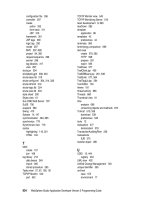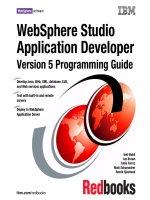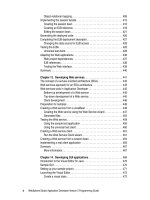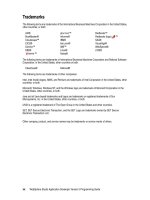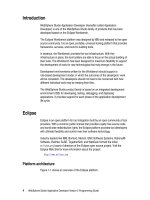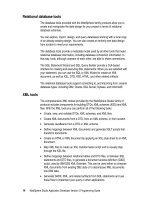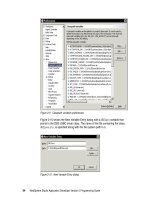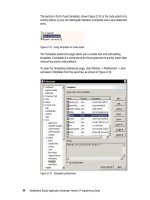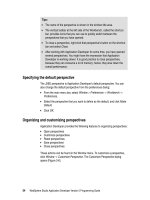WebSphere Studio Application Developer Version 5 Programming Guide part 5 ppsx
Bạn đang xem bản rút gọn của tài liệu. Xem và tải ngay bản đầy đủ của tài liệu tại đây (222.42 KB, 10 trang )
14 WebSphere Studio Application Developer Version 5 Programming Guide
Relational database tools
The database tools provided with the WebSphere family products allow you to
create and manipulate the data design for your project in terms of relational
database schemas.
You can explore, import, design, and query databases working with a local copy
of an already existing design. You can also create an entirely new data design
from scratch to meet your requirements.
The database tools provide a metadata model used by all other tools that need
relational database information, including database connection information. In
that way, tools, although unaware of each other, are able to share connections.
The SQL Statement Wizard and SQL Query Builder provide a GUI-based
interface for creating and executing SQL statements. When you are satisfied with
your statement, you can use the SQL to XML Wizard to create an XML
document, as well as XSL, DTD, XSD, HTML, and other related artifacts.
The relational database tools support connecting to, and importing from, several
database types, including DB2, Oracle, SQL Server, Sybase, and Informix®.
XML tools
The comprehensive XML toolset provided by the WebSphere Studio family of
products includes components for building DTDs, XML schemas (XSD) and XML
files. With the XML tools you can perform all of the following tasks:
Create, view, and validate DTDs, XML schemas, and XML files.
Create XML documents from a DTD, from an XML schema, or from scratch.
Generate JavaBeans from a DTD or XML schema.
Define mappings between XML documents and generate XSLT scripts that
transform documents.
Create an HTML or XML document by applying an XSL style sheet to an XML
document.
Map XML files to create an XSL transformation script and to visually step
through the XSL file.
Define mappings between relational tables and DTD files, or between SQL
statements and DTD files, to generate a document access definition (DAD)
script, used by IBM DB2 XML Extender. This can be used either to compose
XML documents from existing DB2 data or to decompose XML documents
into DB2 data.
Generate DADX, XML, and related artifacts from SQL statements and use
these files to implement your query in other applications.
Chapter 1. Introduction and concepts 15
Java development tools (JDT)
All WebSphere Studio family of products provide a professional-grade Java
development environment with the following capabilities:
Application Developer Version 5 ships with JDK 1.3
Pluggable run-time support for JRE switching and targeting of multiple
run-time environments from IBM and other vendors
Incremental compilation
Ability to run code with errors in methods
Crash protection and auto-recovery
Error reporting and correction
Java text editor with full syntax highlighting and complete content assist
Refactoring tools for reorganizing Java applications
Intelligent search, compare, and merge tools for Java source files
Scrapbook for evaluating code snippets
Web services development tools
Web services represent the next level of function and efficiency in e-business.
Web services are modular, standards-based e-business applications that
businesses can dynamically mix and match in order to perform complex
transactions with minimal programming.
The WebSphere Studio family of products that include the Web services feature,
help you to build and deploy Web services-enabled applications across the
broadest range of software and hardware platforms used by today's businesses.
These tools are based on open, cross-platform standards such as Simple Object
Access Protocol (SOAP), Web Services Description Language (WSDL), and
Universal Description Discovery and Integration (UDDI).
EJB development tools
The WebSphere Studio family of products, except Site Developer Advanced,
feature full EJB support (Application Developer V5 supports EJB 1.1 and 2.0), an
updated EJB test client, an enhanced unit test environment for J2EE, and
deployment support for Web application archive (WAR) files and enterprise
application archive (EAR) files. Entity beans can be mapped to databases, and
EJB components can be generated to tie into transaction processing systems.
XML provides an extended format for deployment descriptors within EJB.
16 WebSphere Studio Application Developer Version 5 Programming Guide
Team collaboration
Team developers do all of their work in their individual Workbenches, and then
periodically release changes to the team code. This model allows individual
developers to work on a team project, share their work with others as changes
are made, and access the work of other developers as the project evolves. At any
time, developers can update their Workbenches by retrieving the changes that
have been made to the team code.
All products of the WebSphere Studio family support the Concurrent Versions
System (CVS) and the Rational ClearCase® LT products.
Other software configuration management (SCM) repositories can be integrated
through the Eclipse Workbench SCM adapters. SCM adapters for commercial
products are provided by the vendors of those products.
Debugging tools
The WebSphere Studio family of products include a debugger that enables you to
detect and diagnose errors in your programs running either locally or remotely.
The debugger allows you to control the execution of your program by setting
breakpoints, suspending launches, stepping through your code, and examining
the contents of variables.
You can debug live server-side code as well as programs running locally on your
workstation.
The debugger includes a debug view that shows threads and stack frames, a
process view that shows all currently running and recently terminated processes,
and a console view that allows developers to interact with running processes.
There are also views that display breakpoints and allow you to inspect variables.
Performance profiling tools
The WebSphere Studio family of products (except for Site Developer) provide
tools that enable you to test the performance of your application. This allows you
to make architectural and implementation changes early in your development
cycle, and significantly reduces the risk of finding serious problems in the final
performance tests.
The profiling tools collect data related to a Java program's run-time behavior, and
present this data in graphical and non-graphical views. This assists you in
visualizing program execution and exploring different patterns within the
program.
Chapter 1. Introduction and concepts 17
These tools are useful for performance analysis and for gaining a deeper
understanding of your Java programs. You can view object creation and garbage
collection, execution sequences, thread interaction, and object references. The
tools also show you which operations take the most time, and help you find and
plug memory leaks. You can easily identify repetitive execution behavior and
eliminate redundancy, while focusing on the highlights of the execution.
Server tools for testing and deployment
The server tools provide a unit test environment where you can test JSPs,
servlets and HTML files, (EJB testing is supported in Application Developer and
Enterprise Developer). You also have the capability to configure other local or
remote servers for integrated testing and debugging of J2EE applications.
The following features are included:
A copy of the complete WebSphere Application Server run-time environment.
Standalone unit testing.
Ability to debug live server-side code using the integrated debugger.
Support for configuring multiple servers.
The server tools support the following run-time environments, which can be
installed locally or remotely and support testing of Web applications:
WebSphere Application Server Version 5.0
WebSphere Application Server Express Version 5.0
WebSphere Application Server Version 4.0 (AEs)
Apache Tomcat Version 4.1
Apache Tomcat Version 4.0
Apache Tomcat Version 3.2
Plug-in development tools
The WebSphere Studio product family (except for Site Developer) include the
plug-in development environment (PDE) that is designed to help you develop
platform plug-ins while working inside the platform Workbench and it provides a
set of platform extension contributions (views, editors, perspectives, etc.) that
collectively streamline the process of developing plug-ins inside the Workbench.
The PDE is not a separate tool, but it is a perspective.
The following project types are supported:
Plug-in project—Application Developer is based on the concept of plug-ins
that have a clearly defined structure and specification. This project supports
the ability to create, test, and deploy a plug-in in the PDE.
18 WebSphere Studio Application Developer Version 5 Programming Guide
Fragment project—A plug-in fragment is used to provide additional plug-in
functionality to an existing plug-in after it has been installed. Fragments are
ideal for shipping features like language or maintenance packs that typically
trail the initial products by a few months.
Plug-in component—PDE attaches a special component nature to plug-in and
fragment projects to differentiate them from other project types. The project
must have a specific folder structure and a component manifest. The project
must be set up with references to all of the plug-in and fragment projects that
will be packaged into the component.
Sample code in this book
All the code examples in this book are based on a banking model (Figure 1-3).
This model was used in the IBM Redbook
EJB 2.0 Development with WebSphere
Studio Application Developer
, SG24-6819.
Figure 1-3 Banking model
The banking model is supported by a relational database called EJBBANK. In this
book we only use a subset of the model: Customer, Account, and TransRecord.
For simple Java and Web development we implement the model in memory. For
advanced development, such as Web with database and EJB, we use the
relational database.
Customer
Account
m:m
1:m
TransRecord
Checking
Savings
update create
business logic
Deposit, Withdraw,
Transfer
Bank
1:m
Chapter 1. Introduction and concepts 19
EJBBANK database
The database consist of the tables shown in Table 1-1. Only the shaded tables
are used in the examples in this document.
Table 1-1 EJBBank tables
See Appendix C, “Additional material” on page 809 for instructions on how to
create and load the EJBBANK database.
Naming convention
All projects and packages used in this book follow a naming convention:
ItsoProGuideXxxxx for projects
itso.xxxx for packages
Table Description
CUSTOMER Bank customer with ID, title, firstname, lastname, user ID, password,
and address.
ACCOUNT Bank account with ID, balance, interest rate, account type, overdraft
amount (CHECKING) and minimum amount (SAVINGS).
TRANSRECORD Transaction record with ID, account ID, transaction type (deposit,
withdraw), and amount.
CUSTACCT Relationship table between CUSTOMER and ACCOUNT.
CUSTADDRESS Customer address with customer ID, street, city, state, zipcode (not
used in this book).
CUSTOMERINFO Customer information, for example picture (not used in this book).
CHECKING Checking account, subtype of account, with overdraft amount (not
used in this book)
SAVINGS Savings account, subtype of account, with minimum amount (not
used in this book).
20 WebSphere Studio Application Developer Version 5 Programming Guide
Summary
This chapter introduced the concepts behind Application Developer and gave an
overview of the features of the various members of the WebSphere Studio family
of tools. The following topics were discussed:
Eclipse
Platform architecture
Workbench features
WebSphere Studio products
What is new in Application Developer Version 5
Too ls
Sample code in this book
© Copyright IBM Corp. 2003. All rights reserved. 21
Chapter 2. Setting up your Workbench
and workspace preferences
After you have installed Application Developer, and before you start creating your
projects, you may want to modify some of the default Workbench settings to suit
your needs or site standards. This chapter describes the most important areas
where you can customize the Application Developer setup.
The following topics are discussed in this chapter:
Workbench basics
Java development preferences
2
Note: Installation of Application Developer is covered in Appendix A, “Product
installation” on page 785.
22 WebSphere Studio Application Developer Version 5 Programming Guide
Workbench basics
Once you have started Application Developer, you will see it opened in a single
window. Application Developer initially displays a perspective — the J2EE
perspective. A perspective contains views, such as the J2EE Navigator view, and
editors. More information regarding perspectives and views are provided in
Chapter 3, “Perspectives, views, and editors” on page 47.
Figure 2-1 shows Application Developer’s initial Workbench.
Figure 2-1 Application Developer Workbench
At the far left of the window is a shortcut bar that allows you to open new
perspectives and navigate between perspectives that are already open. The
name of the active perspective is shown in the title of the window and its icon in
the shortcut bar (left side) is a pushed button.
The J2EE Hierarchy, Tasks, and Outline views are open, along with an editor on
the welcome page. The welcome page provides a quick starting point if you are
eager to customize your Workbench or learn about other installed features.
Chapter 2. Setting up your Workbench and workspace preferences 23
The term Workbench refers to the desktop development environment. Each
Workbench window of Application Developer contains one or more perspectives.
Perspectives contain views and editors and control what appears in certain
menus and toolbars.
Workspace basics
The Application Developer workspace is a private work area for the individual
developer. It holds the environment metadata and the loaded projects’ data in
regular files.
Every time you save a resource, the changes are reflected in the file system.
Normally this is your local file system, but you can also choose to store your
workspace in a network file system (NFS) as well.
Application Developer also allows you to open more than one Workbench at a
time. To open a new Workbench in another window, click
Window -> New
Window
and a new Workbench with the same perspective opens in a new
window.
If you do not specify otherwise, Application Developer creates a default
workspace which is placed in the directory:
My Documents\IBM\wsad\workspace
However, you can change the default workspace by starting Application
Developer with the -data workspacePath parameter where the workspacePath
points to your preferred workspace directory. Relative paths are interpreted
relative to the directory that Application Developer was started from.
Note: The advantages of storing workspaces in NFSs are such as ease of
backup—it is easier for the administrators to back up a team’s workspaces if
they all stand in the same machine—and increased mobility, as you may
connect to the workspace from any machine on the network. The
disadvantage, though, is decreased performance and mobility (laptop).
Tip: If for some reason you ever need to clean your workspace and start over
from scratch, the quickest way would be to exit Application Developer and
rename the workspace directory. Upon restarting Application Developer, you
would have a clean workspace. You could then import the resources that you
still require from the old workspace directory.
